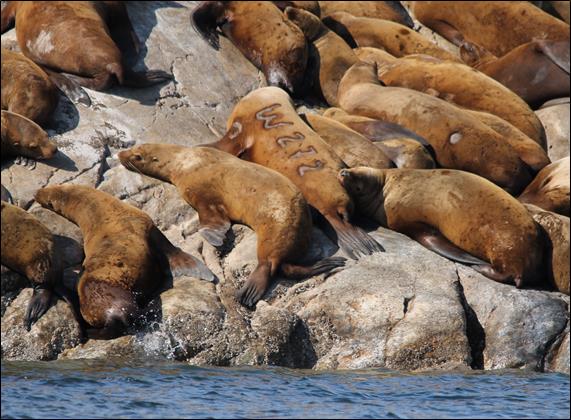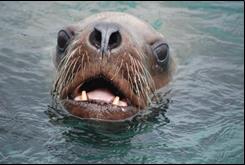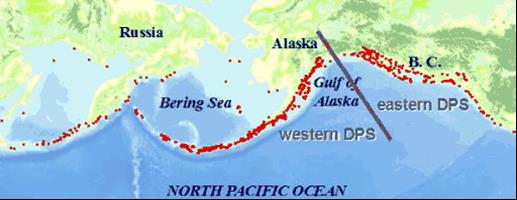About how many branded sea lions are in the park? Is the population healthy?
Project Dates
Ongoing since 2001
Did You Know?
The number of Steller sea lions in the Glacier Bay region has increased at a rate of 8.2% per year since the 1970s, with the most rapid growth occurring at the South Marble Island haulout.
Introduction

Steller sea lion populations in the U.S. are divided into eastern and western “distinct population segments” in the North Pacific. The western population has declined by about 80% in the last 30 years. Although this population has stabilized recently, it is currently listed as “endangered” under the Endangered Species Act. The eastern population has steadily increased by about 3% per year. In October 2013 this population was removed from the “threatened” list due to its strong recovery.
This study was initiated by the Alaska Department of Fish and Game (ADFG) in 2001 as part of a range-wide effort to compare demographic parameters of Steller sea lions. Pups at several Southeast Alaska rookeries, including one within the boundaries of Glacier Bay National Park, were marked with a unique alpha-numeric brand. Each summer during the breeding season, boat-based surveys are conducted by researchers to re-sight the marked individuals. By identifying these known individuals year to year and determining which of the females have dependent newborn pups, researchers can estimate the population’s vital rates, including age-specific survival and reproductive rates, and age at first reproduction. This information assists in their conservation.
Data collected during these surveys help to: 1) determine vital rates of Steller sea lions that can be used in ecosystem-scale, biological, physical, and trophic-level studies; 2) describe distribution and movement patterns; 3) document entanglements in marine debris and ingestion of fishing gear; 4) describe seasonal food habits; 5) estimate the age at which young animals are weaned; 6) better describe Glacier Bay National Park’s role as both breeding and haulout site; and 7) provide information to agencies to inform the decision-making process regarding Steller sea lion management in Alaska.
Methods

Fifty pups were branded at the Graves Rock rookery in 2002, and 43 were branded there in 2005. In 2009, 32 one- and two-year-olds were branded at South Marble Island (South Marble is a haulout, not a natal rookery, so these were the youngest animals that could be found there). Brand re-sight surveys are carried out annually. The surveys are conducted primarily from boats near shore, at a distance from which few or no animals appear agitated.
During the surveys, digital images of marked sea lions are obtained. Animals are counted, and any sea lions with obvious injuries, rope/net entanglements, or ingested fishing gear are photographed and described. In some instances, biologists go ashore for closer observations and to collect scat (feces) that are used to help identify the prey species that Steller sea lions consume.
Findings

Previous brand re-sight efforts have documented that sea lions in the Glacier Bay/Icy Strait region have origins in both the threatened eastern and endangered western population segments. The Graves Rock rookery was established relatively recently (late 1990s), and the population there is increasing faster than at other longer-established rookeries. Analysis of 2002-2009 brand re-sight data indicate that age-specific survival of females born at Graves Rock is higher than females born elsewhere in Southeast
Alaska, and reproductive data suggest that they exhibit higher breeding site fidelity and possibly earlier age of first reproduction. All these factors are indicative of a healthy population.
In 2012 a total of 97 unique brands (38 males and 59 females) were observed at haulouts at Graves Rock (60), South Marble Island (33), and Inian Islands (4). Most were born in Southeast Alaska rookeries, although a few from as far away as southern Oregon and Marmot Island near Kodiak Island were observed. Branded females from four different rookeries pupped at Graves Rock in 2012; to date, all Graves Rock females documented with a newborn pup have given birth at their natal rookery.
Learn More
The Alaska Department of Fish & Game website:
www.adfg.alaska.gov/index.cfm?adfg=marinemammalprogram.stellerresearch
Last updated: August 17, 2017
